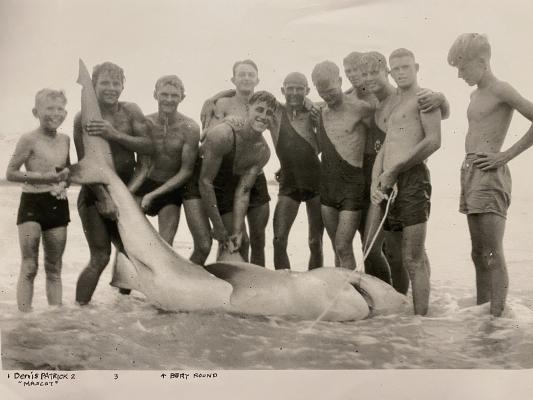With sharks back in the news following the recent attack on Sunshine Coast surfer Joe Hoffman at Crescent Head, PHIL JARRATT recalls our sharky past in this excerpt from PLACE OF SHADOWS, The History of Noosa.
For surfers in the 1960s, Noosa would fast become the most famous “secret spot” on the Australian coast, and eventually become renowned around the world. Many surfers would come to Noosa to surf and eventually make it their home (this writer included), but the first mainstream publicity that surfing in Noosa received was not the kind anyone wanted, least of all the small band of tourism boosters.
By 1960, there was a small crew of Noosa surf club members who surfed the points regularly during holiday periods and summer weekends. John Fancourt from Brisbane was one of them, and he was with other regulars, Merv Cummings, Roy Cronk and Ken Window, surfing First Point on Sunday 17 December 1961 with a young Brisbane dental student named John Graydon Andrews.
The following morning dawned cool and overcast, and while Fancourt and the other lifesavers luxuriated with a sleep-in at the club’s bunkhouse following a Sunday afternoon keg party, Andrews paddled his Malibu board out at First Point and enjoyed good quality waves alone. He was pushing his board through the shallows on his way back in for breakfast at about 6.30 am when a 12-foot bronze whaler shark struck, tearing his left leg off at the knee, then ripping into his left arm as the young surfer tried to fight it off.
Fishermen Rawdon Payne and Keith Bain heard Andrews’ screams and ran from the rocks to pull him from the surf and onto the sand, where the lifesavers, now fully awake, applied tourniquets to try to stop the bleeding as the surfer slipped in and out of consciousness. When an ambulance finally arrived from Cooroy, Andrews was rushed to Nambour Hospital, and later transferred to Royal Brisbane, where his condition fluctuated for almost a week before he died on Christmas Eve.
The Noosa lifesavers, several of whom had already had close encounters with sharks, caught what they believed to be the killer shark and exacted revenge on it. The fatality, along with another in south-east Queensland later in the season, eventually resulted in the introduction of shark nets across the state’s surfing beaches.
Noosa’s reputation for safe surfing had taken a major hit, but the truth was that sharks had been a fact of life there since the earliest lifesaving patrols, and the menace had been getting worse. In 1950, for example, the year began with a three-metre shark cruising Laguna Bay on a daily basis until lifesavers set a bait for it shackled to a buoy 150 metres off Main Beach. The next day they took a surfboat out and found the buoy six kilometres out to sea, the shark still hooked and towing it. It took them two hours to tow the shark back to shore where they killed it with an axe.
Despite this sharky history, the fatality at First Point in 1961 remains the only recorded shark death at Noosa more than 60 years later.
FOOTNOTE: Reader Matt Patrick of Tewantin sent in this photo of his father, Denis who is the “mascot” (far left) to this team of Noosa lifesavers, proudly showing off their shark catch in the early 1950s. Denis, now 79, spent many glorious summers camped with his family in The Woods from the 1940s to the ‘60s. Of this day he recalls: “A drum with the hook baited with a bullock heart was set 100 metres off shore at the mouth of the Noosa River. The lifesaver with the cap towed the shark and drum to a sand island inside the bar on his surf ski.” If not the incident referred to above, then another similar episode in Noosa’s sharky history. Denis also remembers a bloke called Bert Round (or similar) in this picture. Can readers identify anyone else? Contact newsdesk@noosatoday.com.au







